
Men for the Moon
By ROBERT SHERROD
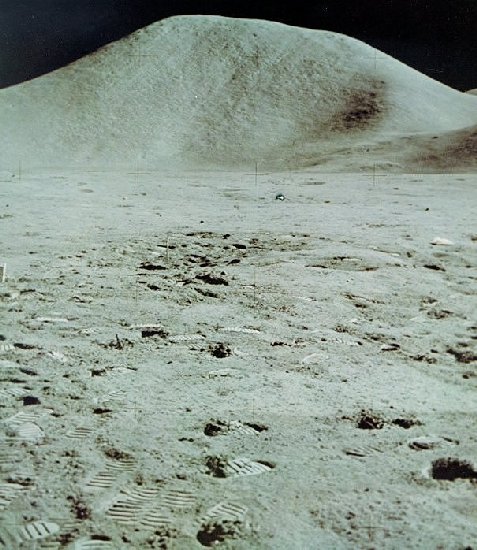
|
| Footprints on the plain at Hadley, beneath the unearthly Apennines, were made by men who had walked the long path of astronaut selection and training. To be one of the dozen men who have so far walked the Moon was to have survived close screening for physical and mental excellence, and to have emerged successfully from long, intensive, and often competitive training. |
On a June day in 1965, following their spectacular Gemini 4 flight, James McDivitt and Edward White flew up to Washington from Houston with their wives and children. The helicopter bearing them from Andrews Air Force Base, Md., had no sooner settled on the White House lawn than Lady Bird Johnson said she wanted them all to spend the night; babysitters would be provided. The two astronauts heard the President call them "Christopher Columbuses of the twentieth century", and he pronounced the United States now caught up with the Russians.
The two astronauts had a parade. They lunched with Vice President Humphrey and congressional leaders, and in the evening they went to the State Department for a reception. Before a packed assemblage of foreign diplomats they showed a 20-minute movie of their flight, which included the first American walk in space by Ed White.
In strode Lyndon B. Johnson himself, who told McDivitt and White, "I want you to join our delegation in Paris." Furthermore, the President wanted them to go now, as soon as they and their wives could pack. He was seething because the Russians had humbled the Americans at the Paris Air Show, where Yuri Gagarin was standing by his spacecraft, shaking hands with everybody and passing out Vostok pins. The French press noted that the lackluster American pavilion was shunned by the crowds.
Patricia McDivitt and Patricia White wailed in unison, "But we have nothing to wear!" Never mind, said LBJ, Lady Bird and Lynda Bird and Luci have plenty of clothes. The ladies retired to the White House bedrooms, and the two Pats were duly outfitted. Long after midnight the Presidential plane took off, bearing as additional passengers Hubert Humphrey, James Webb, and Charles Mathews, the Gemini program manager.
The astronauts made it only in time for the last day and a half of the eleven-day show, but they gave the Russians some real competition. Wherever they appeared, the American jumeaux de space were followed by masses of Frenchmen. "A partial recovery for the United States" was the Paris newspapers' verdict.
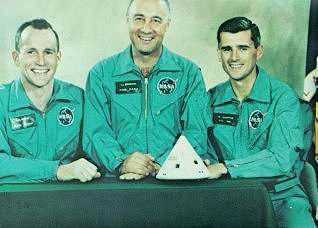
|
Apollo 1 Edward H. White II, senior pilot Virgil I. Grissom, command pilot Roger B. Chaffee, pilot |
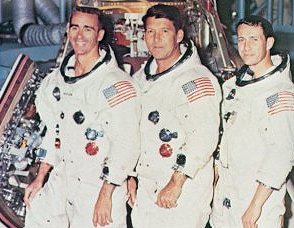
|
Apollo 7 R. Walter Cunningham, lunar module pilot Walter M. Schirra, Jr., commander Donn F. Eisele, command module pilot |
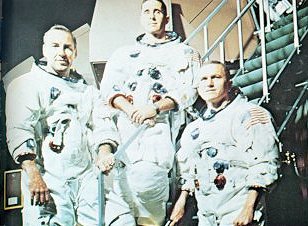
|
Apollo 8 James A. Lovell, command module pilot William A. Anders, lunar module pilot Frank Borman, commander |
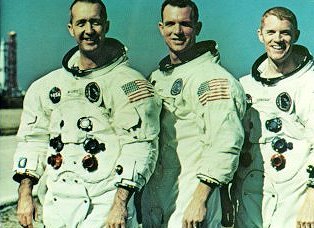
|
Apollo 9 James A. McDivitt, commander David R. Scott, command module pilot Russell L. Schweickart, lunar module pilot |
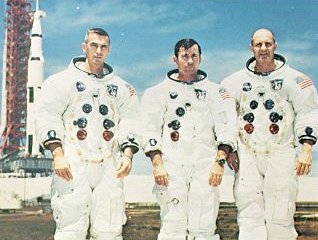
|
Apollo 10 Eugene A. Cernan, lunar module pilot John W. Young, command module pilot Thomas P. Stafford, commander |
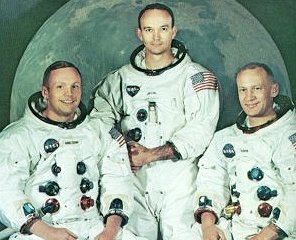
|
Apollo 11 Neil A. Armstrong, commander Michael Collins, command module pilot Edwin E. Aldrin, Jr., lunar module pilot |

|
Apollo 12 Charles Conrad, Jr., commander Richard F. Gordon, command module pilot Alan L. Bean, lunar module pilot |
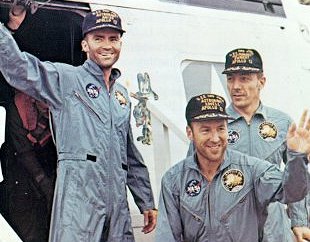
|
Apollo 13 Fred W. Haise, Jr., lunar module pilot James A. Lovell, commander John L. Swigert, Jr., command module pilot |
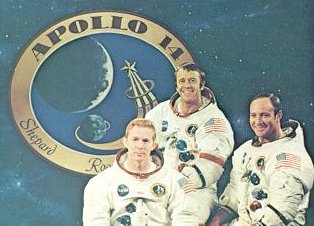
|
Apollo 14 Stuart A. Roosa, command module pilot Alan B. Shepard, Jr., commander Edgar D. Mitchell, lunar module pilot |

|
Apollo 15 David R. Scott, commander Alfred M. Worden, command module pilot James B. Irwin, lunar module pilot |
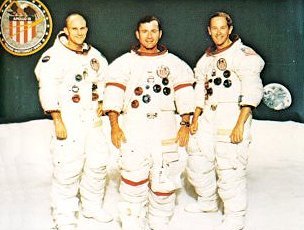
|
Apollo 16 Thomas K. Mattingly II, command module pilot John W. Young, commander Charies M. Duke, Jr., lunar module pilot |
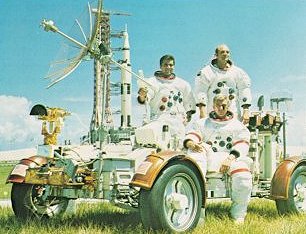
|
Apollo 17 Harrison H. Schmitt, lunar module pilot Ronald E. Evans, command module pilot Eugene A. Cernan, commander |
Such were the glory days, when to be an astronaut was to be in heaven - if one could endure the slavery that was the obverse of the coin. Altogether there were seven groups of astronauts, a total of 73, of whom 43 flew before the long night settled on manned space flight after the Apollo-Soyuz mission in July 1975. Twenty-nine of these filled the 33 slots in Apollo, with which we are principally concerned here.
What did it take to become an astronaut? Dr. Robert Voas, a psychologist who was the Mercury astronauts' training director, detailed the required characteristics as he saw them: intelligence without genius, knowledge without inflexibility, a high degree of skill without overtraining, fear but not cowardice, bravery without foolhardiness, self-confidence without egotism, physical fitness without being muscle-bound, a preference for participatory over spectator sports, frankness without blabbermouthing, enjoyment of life without excess, humor without disproportion, fast reflexes without panic in a crisis. These ideals were fulfilled to a high degree.
| Next |